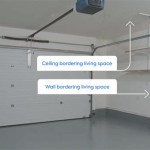Can I Replace My Garage Door Opener Myself? Considerations and Steps
Replacing a garage door opener can appear to be a manageable do-it-yourself project. While it's certainly feasible for homeowners with some mechanical aptitude and a good understanding of electrical safety protocols, it is essential to carefully evaluate the complexities involved before commencing. This article explores the key factors to consider before deciding if you can replace your garage door opener yourself, outlining potential challenges and providing a general overview of the replacement process.
The decision to undertake a garage door opener replacement should be based on a realistic assessment of your skills, available time, and comfort level with potential risks. Improper installation can lead to malfunctions, safety hazards, and even damage to your garage door or property. Professional installation ensures adherence to safety standards and proper functionality, providing peace of mind.
Assessing Your Skills and Experience
Before considering the DIY route, honestly evaluate your experience with similar projects. Have you successfully completed electrical wiring tasks before? Are you comfortable working with power tools like drills and wrenches? Can you accurately follow detailed instructions and diagrams? Garage door opener replacement involves electrical connections, mechanical adjustments, and the ability to lift and maneuver heavy components. If you lack experience in these areas, professional installation might be the more prudent choice.
Specifically, consider your familiarity with the different types of garage door openers. Chain drive, belt drive, screw drive, and direct drive openers all have unique installation requirements. Understanding these differences is crucial for a successful replacement. For example, chain drive openers require careful adjustment of the chain tension, while belt drive openers need precise alignment of the belt and pulleys.
Consider your physical capabilities as well. Garage door openers can be heavy, and the installation process often involves working overhead for extended periods. If you have physical limitations, such as back problems or difficulty lifting heavy objects, attempting the replacement yourself could lead to injury. Enlist the help of a capable assistant or opt for professional installation to avoid potential strain or accidents.
Understanding the Risks and Potential Problems
Garage door openers operate on electrical power, presenting a risk of electric shock if proper safety precautions are not followed. Always disconnect the power supply to the opener at the circuit breaker before beginning any work. Verify that the power is off using a non-contact voltage tester. Failure to do so could result in serious injury or even death.
Garage door springs are under extreme tension, and any mishandling can result in serious injury. Springs are specifically engineered to counterbalance the weight of the door, and any attempt to adjust or remove them without the proper tools and knowledge is extremely dangerous. Ideally, the springs should be professionally serviced or replaced if they are worn or damaged. Never attempt to adjust the garage door springs unless you are a qualified technician.
Incorrect installation can lead to the garage door malfunctioning, potentially causing damage to the door itself, the opener, or surrounding structures. A misaligned door can also pose a safety hazard, increasing the risk of the door falling unexpectedly. Proper alignment and adjustment are crucial for safe and reliable operation. If you're unsure about any aspect of the installation process, consult a professional.
Compatibility issues can also arise. The new opener must be compatible with your existing garage door and track system. Not all openers are suitable for all types of doors. Additionally, you need to ensure that the opener is compatible with your garage wiring and electrical system. Purchasing the wrong type of opener or failing to address compatibility issues can lead to significant complications and additional expenses.
A General Overview of the Replacement Process
The following steps provide a general overview of the garage door opener replacement process. It is crucial to consult the specific instructions provided by the manufacturer of your new opener for detailed guidance.
1. Preparation: Begin by gathering all necessary tools and materials, including a wrench set, socket set, screwdrivers, pliers, wire strippers, a drill, a ladder, safety glasses, and work gloves. Carefully read the installation manual for your new opener and familiarize yourself with the instructions.
2. Disconnecting the Existing Opener: First, disconnect the power to the opener at the circuit breaker. Then, detach the opener from the garage door by disconnecting the chain, belt, or screw drive mechanism. Disconnect the electrical wiring, carefully labeling each wire for reinstallation. Remove the old opener from its mounting brackets, taking care to support its weight as you detach it.
3. Installing the New Mounting Brackets: Install the new mounting brackets according to the manufacturer's instructions. Ensure they are securely attached to the garage structure. Proper alignment of the brackets is essential for the smooth operation of the opener.
4. Assembling the New Opener: Assemble the new opener according to the manufacturer's instructions. This typically involves attaching the motor unit to the rail and installing the chain, belt, or screw drive mechanism.
5. Installing the Opener: Lift the assembled opener into position and attach it to the mounting brackets. Ensure that the opener is level and securely fastened. Connect the opener to the garage door using the provided hardware.
6. Wiring the Opener: Connect the electrical wiring to the opener, carefully following the wiring diagram provided in the installation manual. Ensure that all connections are secure and properly insulated. Connect the safety sensors to the opener, ensuring they are properly aligned and functioning correctly. These sensors are crucial for preventing the door from closing if an obstruction is detected.
7. Adjusting and Testing: Adjust the opener's travel limits and force settings according to the manufacturer's instructions. Test the opener to ensure it opens and closes smoothly and reliably. Verify that the safety sensors are functioning correctly by placing an obstruction in the path of the door. The door should stop and reverse direction if an obstruction is detected. Make any necessary adjustments to ensure optimal performance and safety.
8. Programming and Final Checks: Program the remote controls and keypad according to the manufacturer's instructions. Perform a final inspection of the installation to ensure that everything is properly connected and functioning correctly. Clean up the work area and dispose of any waste materials properly.
Even with these steps, remember that each garage door and opener model presents unique challenges. The instructions provided with your specific opener are paramount and should be followed meticulously.
While the individual steps might seem straightforward, combining them into a safe and effective installation requires careful attention to detail. Missed steps or improper adjustments can lead to ongoing problems and potential safety hazards.
Ultimately, the decision of whether or not to replace your garage door opener yourself depends on your individual skills, experience, and comfort level. If you are confident in your abilities and willing to take the time to do the job correctly, it can be a rewarding DIY project. However, if you have any doubts or concerns, it is always best to consult a qualified professional.

Install Your Own Garage Door Opener

How To Install A Garage Door Opener

Diy Garage Door Opener Replacement

How To Replace A Garage Door Opener In 6 Steps

How To Replace A Garage Door Opener In 6 Steps

How To Replace A Garage Door Opener In 6 Steps

Cost For Garage Door Opener Installation Let S Take A Look

Can I Fix The Chain On A Garage Door By Myself World Of Doors

Can I Replace A Garage Door Spring Myself In Arlington Tx

Should I Install A Garage Door Opener By Myself 1 Fleet Services








